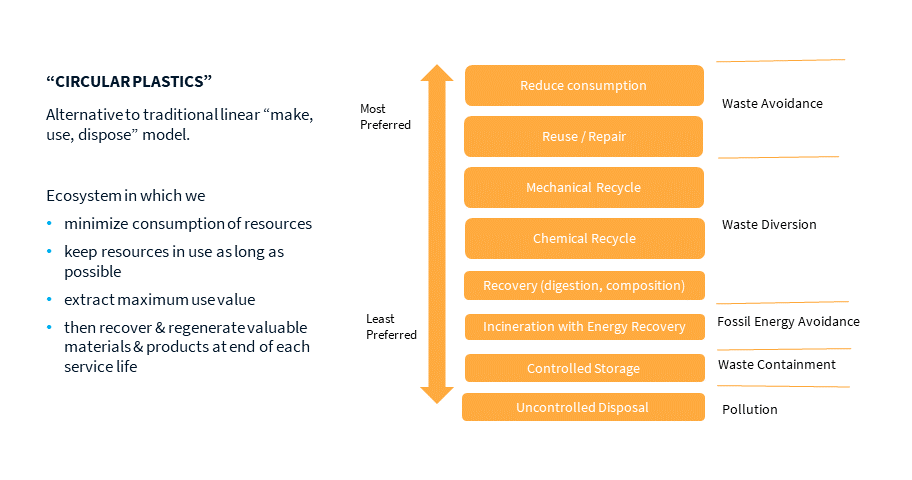Circular Plastics – How Do You Define Them?

Chemical Market Analytics’ definition of circular plastics is the alternative to the traditional linear make-use and dispose model. It is a transition to an ecosystem in which we minimize consumption of resources, keep those resources in use for as long as possible, extract the maximum value during their use, and then recover and regenerate valuable materials and products at the end of the service life. In our view, waste avoidance and waste diversion, the first five elements shown in the chart are consistent with achieving a circular plastics model. We do not consider incineration or landfill as part of a circular plastic solution. The circular plastic scenario in this service essentially comprises of five tools at disposal:
- Reduce consumption
- Reuse/Repair
- Mechanical Recycle
- Chemical Recycle
- Recover (digestion, composition)
 As the world looks to reduce its dependence on fossil-based resources, the transition from a linear to a circular plastics ecosystem is a critical global challenge. A successful transition will require unprecedented growth in infrastructure. The implementation of new business models and a critical alignment of stakeholder policies are all purposely driven by effective government regulations and incentives.
As the world looks to reduce its dependence on fossil-based resources, the transition from a linear to a circular plastics ecosystem is a critical global challenge. A successful transition will require unprecedented growth in infrastructure. The implementation of new business models and a critical alignment of stakeholder policies are all purposely driven by effective government regulations and incentives.
The circular plastic service examines the various levers that will determine the pace and efficacy of this plastic transition within the context of its carbon footprint. The circular plastic service differs from other market services offered by chemical market analytics in that this service which is comprised of individual modules, each addressing a particular aspect of the overall plastic circularity transition, with each module having a delivery format and update schedule that best fits the module’s mission.
About Circular Plastics Service
Circular Plastics Service provides comprehensive analytics and insight for the plastics value chain’s transition from a linear to a circular economy. The service addresses the implications of carbon intensity and the impact on future capital investments within the context of energy transition and carbon valuation, amid changing policy and regulations. This service quantifies the magnitude and timing of substantial market shifts, identifies key regulatory and societal risks and provides ongoing tracking of fast-moving developments.

Anthony Palmer
Vice President, Circular Plastics and Chemical Sustainability
Chemical Market Analytics by OPIS, a Dow Jones Company

